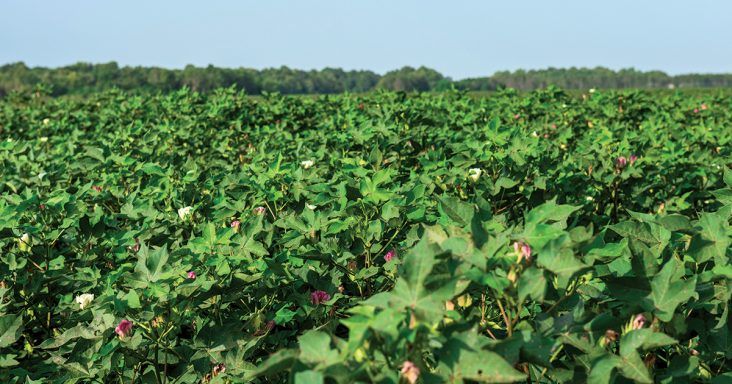Carbon-friendly: Farmers adopt regenerative practices to save money and the environment
by December 4, 2019 8:21 am 1,488 views

The agriculture sector can at times be the most volatile economic sector in the country. Prices for a broad range of crops can vary by wide margins each growing season, and other factors such as trade wars and weather can also impact the profitability of any crop. Farmers can’t control a lot of these factors, but one part, input costs, can be controlled to a degree, and now those could improve the environment.
Cotton plant farmer Adam Chappell told Talk Business & Politics he’s using practices on his farm that comport with The Terraton Initiative, a global effort to reduce carbon in the atmosphere and put more in the soil. The initiative’s goal is to remove 1 trillion tons of carbon from the atmosphere and to have 12 billion acres dedicated to regenerative practices. About 11 million farm acres have committed to the program nationwide with about 300,000 of those acres in Arkansas.
Chappell said he didn’t start using these growing methods to stop global warming. These practices have helped him reduce his operating budgets by almost half on his farm where he grows cotton, soybeans, corn and rice. It may open a new revenue stream for his farm, too.
“From a farmer’s perspective the goal is to take the impact of carbon … to collect it and deposit it back in the soil,” he said.
Carbon is essentially food for plants. Soil that is carbon rich will grow better plants, Chappell said. One thing he doesn’t do on his 8,500-acre farm is till the soil. Tilling the soil costs a lot of money in fuel and equipment costs and it causes the release of carbon.
Instead of tilling, cover crops are grown on his fields year-round. Cover crops can include rye grass, crimson clover, oats, cereal rye and others, according to the United State Department of Agriculture. This significantly reduced the amount of herbicides and synthetic fertilizer used on his farm, Chappell added.
Chappell, who started farming in 2006 with his brother and father, said they are developing a cattle herd that will roam the fields as well. Cattle increase the organic diversity of the soil and will feed on the cover crops, meaning his farm will save more money on fertilizer and herbicides. His farm had 46 head of cattle in 2018, and the number is expected to balloon to 100 by the end of this year.
There is another way for farmers to profit from regenerative efforts. Carbon credits can be generated from higher carbon soil concentrations, Randall Spock, senior carbon manager at Indigo Ag told Talk Business & Politics. Indigo is a Boston-based company that connects farmers to carbon credit buyers, he said. The company has operations in Memphis, Tenn.
So what is a carbon credit?
More than 40 countries worldwide participate in the national and international exchange of carbon credit certificates or allowances given to companies to allow them to produce up to one metric ton of carbon, according to the World Economic Forum. In the European Union, countries have to reduce their emissions and companies that exceed their emission allowances are fined.
For example, it takes about 1 ton of steel to build a car. Producing 1 ton of steel emits 2 tons of carbon dioxide. At current prices, this will cost a steel producer in the EU roughly $16 if it’s more than the allowance. Other companies that can avoid CO2 emissions at little cost (below $16) will sell their rights to those companies that have higher emission reduction costs, according to the Forum.
Carbon credits are not the same as carbon offsets. The latter also represents 1 ton of carbon dioxide or equivalent greenhouse gas, it is generated by a reduction in emissions made by a voluntary project designed specifically for that purpose, according to Native Energy.
Carbon offsets are generated by projects with clearly defined objectives, usually outside the confines of a company’s own operational sites. Typical carbon offset projects include building wind turbines or solar farms, supporting methane reduction projects, planting trees or preserving forests, according to Native Energy.
How this works for farmers who work with Indigo is pretty simple, Spock said.
After a producer opts into the program, they are enrolled in the company’s carbon offset program. The farmer’s soil is tested and a baseline is established. Agronomists and other specialists are brought in, and they give suggestions on ways to enhance the carbon levels in that particular field.
Once the regenerative practices are started, more data from the soil is collected to establish the carbon credit. Those credits are then shopped to companies, organizations, and individuals.
When Indigo started this program, the goal was to have about 1 million acres dedicated at first. That number has ballooned to more than 10 million, and Spock said it’s a good problem to have. The company has grown rapidly and keeping up with demands from farmers is a top goal.
“It has greatly exceeded our expectations,” he added.
Chappell, who was recently featured in National Geographic, said he is pleased with the results of regenerative practices. Farmers can’t control the prices or weather, but spending less to produce more abundant and higher quality crops is worth it.
“The more carbon you have … basically the richer the soil is,” he said.
